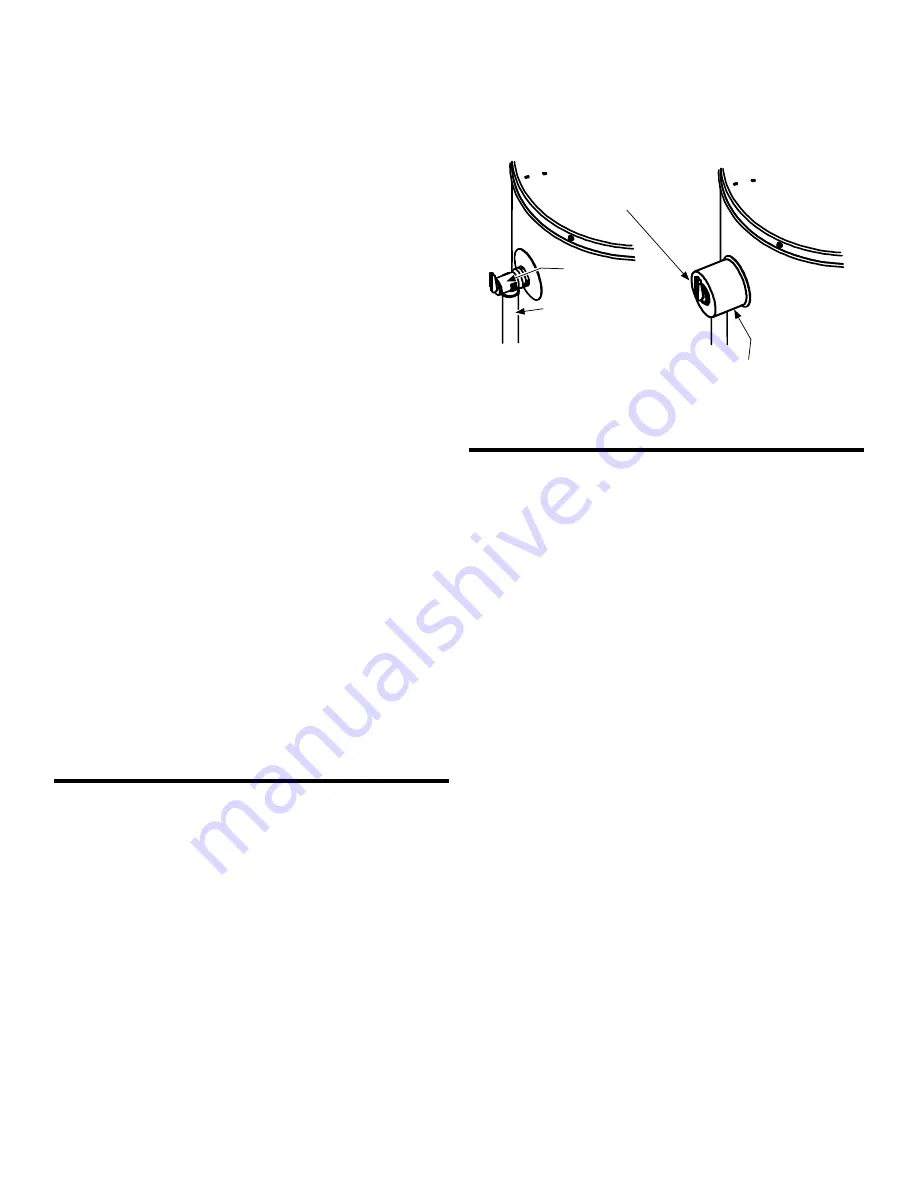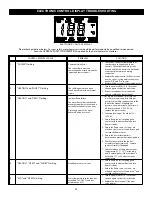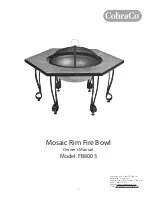
17
For protection against excessive pressures and
temperatures, a temperature and pressure relief valve must
be installed in the opening marked “T & P RELIEF VALVE”
(see Figure 15A). This valve must be design certified by
a nationally recognized testing laboratory that maintains
periodic inspection of the production of listed equipment or
materials as meeting the requirements for Relief Valves for
Hot Water Supply Systems, ANSI Z21.22. The function of
the temperature and pressure relief valve is to discharge
water in large quantities in the event of excessive
temperature or pressure developing in the water heater.
The valve’s relief pressure must not exceed the working
pressure of the water heater as stated on the rating plate.
IMPORTANT: Only a new temperature and pressure relief
valve should be used with your water heater. Do not use an
old or existing valve as it may be damaged or not adequate
for the working pressure of the new water heater. Do not
place any valve between the relief valve and the tank.
The Temperature & Pressure Relief Valve:
•
Must not be in contact with any electrical part.
•
Must be connected to an adequate discharge line.
•
Must not be rated higher than the working pressure
shown on the rating plate of the water heater.
The Discharge Line:
•
Must not be smaller than the pipe size of the relief
valve or have any reducing coupling installed in the
discharge line.
•
Must not be capped, blocked, plugged or contain any
valve between the relief valve and the end of the dis-
charge line.
•
Must terminate a maximum of six inches above a floor
drain or external to the building. In cold climates, it is
recommended that the discharge pipe be terminated at
an adequate drain inside the building.
•
Must be capable of withstanding 250°F (121°C) without
distortion.
•
Must be installed to allow complete drainage of both
the valve and discharge line.
T&P Relief Valve and Pipe Insulation
1. Locate the temperature and relief valve on the water
heater (also known as a T&P Relief Valve, Figure 15B).
2. Locate the slit running the length of the insulation.
3 Spread this slit open and slip it up under the T&P Relief
Valve. See Figure 15B. Apply gentle pressure to the
insulation to ensure it is fully seated on the T&P Relief
Valve. Once sealed secure the insulation with a section
of duct tape, electrical tape, or equivalent.
IMPORTANT: The insulation or tape must not block the
discharge opening or hinder access to the manual relief
lever. Ensure a discharge pipe is installed into the T&P
valve discharge opening per the instructions manual.
4. Locate the hot water (outlet) & cold water (inlet) pipes to
the water heater.
5. Locate the slit running the length of a section of pipe
insulation.
6. Spread the slit open and slip the insulation over the cold
water (inlet) pipe. Apply gentle pressure along the length
of the insulation to ensure it is fully seated around the
pipe. Also ensure that the base of insulation is flush with
the water heater. Once seated, secure the insulation with
duct tape, electrical tape, or equivalent.
7. Repeat steps 5 through 6 for the hot water (outlet) pipe.
8. Add additional sections of pipe insulation as needed.
T&P Relief Valve Insulation
Manual Relief Lever
T&P Relief Valve
T&P Relief Valve
Drain Line
FIGURE 15B.
Combination Space Heating/Potable
Water System
Some water heater models are equipped with inlet/outlet
connections for use with space heating applications. If this
water heater is to be used to supply both space heating
and domestic potable (drinking) water, the instructions
listed below must be followed.
•
Be sure to follow the manual(s) shipped with the air
handler system.
•
This water heater is not to be used as a replacement
for an existing boiler installation.
•
Do not use with piping that has been treated with
chromates, boiler seal or other chemicals and do not
add any chemicals to the water heater piping.
•
If the space heating system requires water
temperatures in excess of 120°F, a mixing valve
or an anti-scald device should be installed per its
manufacturer’s instructions in the domestic (potable)
hot water supply to limit the risk of scald injury.
•
Pumps, valves, piping and fittings must be compatible
with potable water.
•
A properly installed flow control valve is required to
prevent thermosiphoning. Thermosiphoning is the
result of a continuous flow of water through the air
handler circuit during the off cycle. Weeping (blow off)
of the temperature and pressure relief valve (T & P)
or higher than normal water temperatures are the first
signs of thermosiphoning.
•
The domestic hot water line from the water heater
should be vertical past any mixing valve or supply line to
the air handler to remove air bubbles from the system.
Otherwise, these bubbles will be trapped in the air
handler heat exchanger coil, reducing the efficiency.
•
Do not connect the water heater to any system or
components previously used with non-potable water
heating appliances when used to supply potable water.
Some jurisdictions may require a backflow preventer in the
incoming cold water line. This may cause the temperature
and pressure relief valve on the water heater to
discharge or weep due to expansion of the heated water.
















































